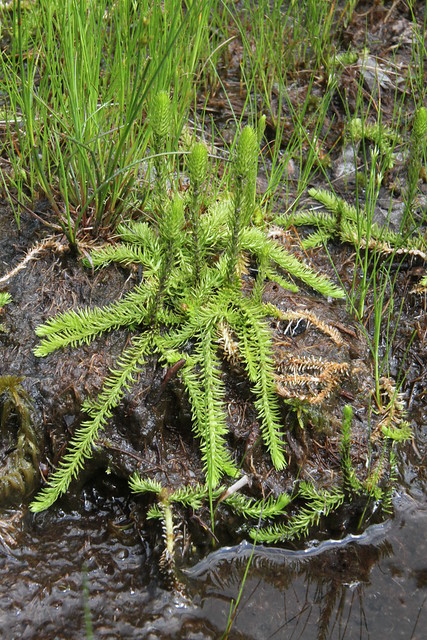Map Snapshot




13 Records
Seasonality Snapshot
Source: Wikipedia
| Lycopodiella inundata | |
|---|---|

| |
| Scientific classification | |
| Kingdom: | Plantae |
| Clade: | Tracheophytes |
| Clade: | Lycophytes |
| Class: | Lycopodiopsida |
| Order: | Lycopodiales |
| Family: | Lycopodiaceae |
| Genus: | Lycopodiella |
| Species: | L. inundata
|
| Binomial name | |
| Lycopodiella inundata | |
| Synonyms | |
|
Lycopodium inundatum L. | |
Lycopodiella inundata is a species of club moss known by the common names inundated club moss,[2] marsh clubmoss[3] and northern bog club moss. It has a circumpolar and circumboreal distribution, occurring throughout the northern Northern Hemisphere from the Arctic to montane temperate regions in Eurasia and North America. It grows in wet habitat, such as bogs, ponds, moist spots on the tundra, and long-standing borrow pits.
Description
[edit]It is a small plant forming patches on the ground, its leafy sterile stems branching and lying horizontal along the ground, rooting at intervals. The sporing cone-bearing stems stand erect in July and August, a few centimeters tall. The leaves are curving, green, narrow, and sharply pointed, measuring a few millimeters long.[4]
Distribution and habitat
[edit]This club moss is an arctic-alpine species with a circumpolar boreal and montane distribution in the Northern Hemisphere. It mostly occurs in Europe, but is also present in East Asia and North America. In the British Isles it is classified as a UK Priority Species as it is rare and seems to be on the decline. It occurs in Scotland and the western fringes of England and Wales, and at scattered locations elsewhere. Nevertheless, it can increase rapidly when the conditions are right, as happened at Llyn Cwm-y-ffynnon in Wales on bare peat substrates uncolonised by other plants because of winter inundation, cattle poaching and peat cutting.[5] It occurs at a few locations across Ireland and at one single location in Northern Ireland, at Peatlands Park in County Armagh, and because of its rarity, it is listed as a Northern Ireland Priority Species.[4]
References
[edit]- ^ Lansdown, R.V. (2014). "Lycopodiella inundata". IUCN Red List of Threatened Species. 2014: e.T19619815A19621031. doi:10.2305/IUCN.UK.2014-1.RLTS.T19619815A19621031.en. Retrieved 23 August 2021.
- ^ NRCS. "Lycopodiella inundata". PLANTS Database. United States Department of Agriculture (USDA). Retrieved 24 June 2015.
- ^ BSBI List 2007 (xls). Botanical Society of Britain and Ireland. Archived from the original (xls) on 2015-06-26. Retrieved 2014-10-17.
- ^ a b Hackney, Paul. "Lycopodiella inundata – marsh clubmoss". Northern Ireland Priority Species. Retrieved 10 March 2020.
- ^ "Polystichum lonchitis". Online Atlas of the British and Irish Flora. Retrieved 10 March 2020.
External links
[edit] Media related to Lycopodiella inundata at Wikimedia Commons
Media related to Lycopodiella inundata at Wikimedia Commons- Jepson Manual Treatment
- NRCS. "Lycopodiella inundata". PLANTS Database. United States Department of Agriculture (USDA).
- Rook Profile Archived 2008-11-21 at the Wayback Machine
- Wagner Jr., Warren H.; Beitel, Joseph M. (1993). "Lycopodiella inundata". In Flora of North America Editorial Committee (ed.). Flora of North America North of Mexico (FNA). Vol. 2. New York and Oxford: Oxford University Press – via eFloras.org, Missouri Botanical Garden, St. Louis, MO & Harvard University Herbaria, Cambridge, MA.
- Lycopodiella inundata in the CalPhotos photo database, University of California, Berkeley


